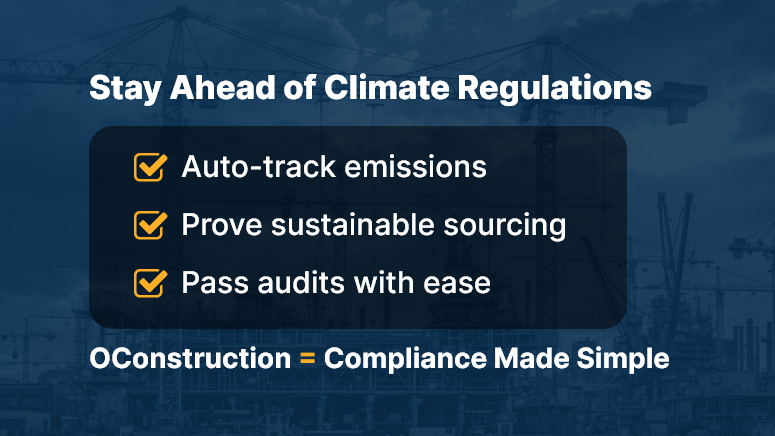Over the last year, 85% of construction companies reported new challenges due to tightening construction climate regulations — from carbon limits to sustainable material sourcing. These changes matter because non‑compliance now risks fines, project delays, and reputational damage.
Furthermore, clients increasingly demand greener builds. In this article, you’ll learn why adapting to these climate rules is critical, what leads to regulatory missteps, and how OConstruction’s integrated digital platform empowers project leads and sustainability managers to comply efficiently.
You’ll discover actionable strategies and a real‑world example that proves compliance can be a competitive advantage—all while addressing the core focus on construction climate regulations.

Business Relevance & Why It Matters
Today, construction climate regulations drive critical shifts across design, procurement, and site operations. Governments are enforcing stricter emission caps, material sourcing metrics, and waste‑management rules.
When companies fall behind, they face penalties, project stoppages, and loss of client trust. On the other hand, forward‑looking firms gain access to green contracts and cost savings through efficiency.
Contract managers, compliance officers, and project executives benefit most from compliance tools. For instance:
Use Case 1:
A commercial builder must track carbon emissions per project to meet local regulatory thresholds. Without data, meeting compliance becomes guesswork.
Use Case 2:
A public infrastructure firm needs proof of sustainable sourcing for materials. Manual spreadsheets fall short.
Use Case 3:
A residential developer wants to benchmark energy usage across projects. Lack of centralized insight prevents optimization.
Clearly, the pain — manual tracking, fragmented data, regulatory risk — contrasts with the solution: a unified platform that logs emissions, procurement data, and audit proofs. By utilizing OConstruction’s platform, companies ensure construction climate regulations become manageable, actionable, and even profitable.
Best Practices, Frameworks & Actionable Strategies
1. Do’s and Don’ts for Regulatory Adaptation
- Do implement standardized data entry workflows for reporting emissions, waste, and sustainable materials. This ensures consistent audit documentation.
- Don’t rely on siloed Excel files. Disparate systems impede traceability and increase regulatory error risk.
- Do use centralized dashboards showing compliance status by project. This offers real-time visibility to all stakeholders.
- Don’t delay data updates until month‑end. Late reporting can breach compliance deadlines and lead to penalties.
2. Quick Wins & Best Practices
- Automate Emissions Tracking
Use integrated meter or IoT inputs to record site‑level energy and fuel usage automatically. It saves time and improves accuracy.
- Use Material Sourcing Checklists
Pre‑loaded lists of green vendors and sustainable materials help procurement meet regulatory requirements effortlessly.
- Generate Real‑Time Compliance Reports
Provide on-demand dashboards showing carbon footprints, waste diversion, and regulatory thresholds at both project and corporate levels.
3. Step‑by‑Step Framework Using OConstruction
- Step 1: Set regulatory parameters per project — local carbon caps, waste diversion rates, sustainable material goals.
- Step 2: Log procurement details through the platform, tagging each item’s sustainability score.
- Step 3: Automate field data collection — energy use, transport emissions, waste volumes — through mobile input.
- Step 4: Platform aggregates data, flags gaps, and alerts stakeholders before thresholds breach.
- Step 5: Produce audit‑ready compliance reports and share them with regulators or clients instantly.
This framework demonstrates how OConstruction ties each phase of adaptation to the platform’s digital compliance capabilities, enabling transparent and proactive alignment with construction climate regulations.
Customer Story/Use Case Example
For example, GreenBuild Infrastructure, a commercial contractor, adapted swiftly to new construction climate regulations around carbon intensity.
They used OConstruction’s compliance module to set up carbon caps per project and automatically capture energy consumption data via connected sensors.
They also tagged all material orders by sustainability category. As a result:
- They achieved 20% reduction in carbon emissions across three major sites
- They passed regulatory audits without a single compliance exception
- They won a competitive green tender due to transparent reporting capabilities
By centralizing emissions tracking, procurement data, and audit logs, GreenBuild turned regulatory changes into competitive differentiators.
Key Takeaways & Closing Summary
Construction climate regulations no longer represent just external pressure—they offer an opportunity to lead in sustainability and efficiency.
By leveraging a digital platform that automates emissions tracking, centralizes procurement data, and enables audit‑ready compliance, you turn regulatory obligations into strategic strengths.
You gain:
- Real-time compliance visibility across all projects
- Streamlined procurement and material tracking aligned with green standards
- Audit-ready documentation that supports bids, client confidence, and regulatory proof
Ultimately, adapting effectively to construction climate regulations ensures you stay compliant, competitive, and future‑proof.



